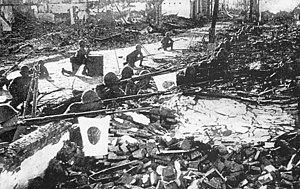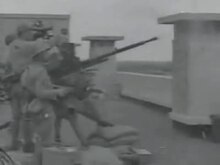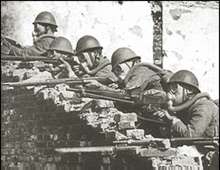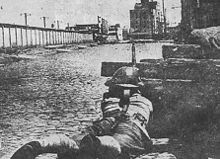Battle of Shanghai (1937)
| date | August 13 to November 9, 1937 |
|---|---|
| place | Shanghai , Republic of China |
| output | Japanese victory |
| Parties to the conflict | |
|---|---|
| Commander | |
| Troop strength | |
| 500,000 to 700,000 men in 71 divisions 87 aircraft |
270,000 men in 8 divisions and 6 brigades, 500 aircraft, 300 tanks , 130 warships |
| losses | |
|
130,000 dead, 60,000 wounded |
About 40,000 dead, more than 50,000 wounded |
1937–1939
Marco Polo Bridge - Beijing-Tianjin - Chahar - Shanghai ( Sihang warehouse ) - Beijing-Hankou Railway - Tianjin-Pukou Railway - Taiyuan ( Pingxingguan , Xinkou ) - Nanjing - Xuzhou ( Tai'erzhuang ) - Henan - Lanfeng - Amoy - Wuhan ( Wanjialing ) - Canton - Hainan - Nanchang - ( Xiushui ) - Chongqing - Suixian-Zaoyang - ( Shantou ) - Changsha (1939) - South Guangxi - ( Kunlun Pass ) - Winter Offensive - ( Wuyuan )
1940–1942
Zaoyang-Yichang - Hundred Regiments - Central Hubei - South Henan - West Hebei - Shanggao - Shanxi - Changsha (1941) - Changsha (1942) - Yunnan-Burma Road - Zhejiang-Jiangxi - Sichuan
1943–1945
West Hubei - North Burma and West Yunnan - Changde - Ichi-gō - Henan - Changsha (1944) - Guilin – Liuzhou - West Henan and North Hubei - West Hunan - Guangxi (1945) - Manchukuo (1945)
The Battle of Shanghai from August 13 to November 9, 1937 was the first major battle in the Second Sino-Japanese War . The Japanese army attacked the Chinese city of Shanghai in August 1937 . After heavy fighting in the city center, which ended with the destruction of much of Shanghai, Japanese troops captured the city in November. The losses were very high on both sides.
background
In the course of the Manchuria crisis of 1931/32, during which Japan occupied Manchuria and established the puppet state of Manchukuo there, the “ First Shanghai Incident ” between Japanese and national Chinese troops occurred in Shanghai after a call for a boycott of Japanese goods . The Japanese had achieved the demilitarization of Shanghai and its surrounding area by the Chinese and the right to station a small Japanese garrison to protect the foreign concessions in the city. In the period that followed, hostilities between China and Japan intensified. The incident at the Marco Polo Bridge on July 7, 1937 led to the Second Sino-Japanese War . Japan occupied large areas of northern China without major resistance.
After the rapid advance of the Japanese in the north, the Chinese leader Chiang Kai-shek actively worked to relocate the fighting to Shanghai. On the one hand, he hoped to gain international attention for the widening war through the concessions made by various European powers there. On the other hand, together with his German military advisors around Alexander von Falkenhausen, he came to the conclusion that the topographical nature in the north favored the Japanese, who were equipped for rapid advances, so far that an effective defense was not possible there. As many troops as possible should therefore be relocated to the urban and watercourse-crisscrossed area around Shanghai. Even before and during the battle, the German advisory staff vehemently advocated holding Shanghai, as the Japanese would lose the initiative in the entire conflict and might be ready for a peace agreement quickly. In addition to this negative moral effect on the Japanese, Chiang hoped above all to strengthen the morale of the Chinese people with a successful or at least long defense of Shanghai and to be able to gather them together behind him. For this reason, the best trained Chinese troops, some of which were armed with German weapons, were relocated to the city.
The immediate cause for the outbreak of fighting was, from a Japanese perspective, an incident on the evening of August 9, in which a Japanese lieutenant named Ōyama Isao of the Shanghai-based Naval Special Landing Forces and his driver in front of the Shanghai-Hongqiao airport from Chinese Self-defense forces were killed. The Japanese, who had only 4,000 men in Shanghai, felt threatened by the Chinese, who concentrated a force more than ten times as strong in the area around the city. But it would easily be possible for the Japanese to reinforce their troops in the event that fighting broke out from the motherland.
The Japanese believed in a quick victory. The plan was to conquer Shanghai in three days and all of China in three months. Since many older reservists served in the Japanese army who had families at home, attempts were made to keep the troop morale high with the prospect of a quick victory.
course
Fight in Zhabei
Starting on August 13, there was the first fighting between Chinese troops of the 88th Infantry Division arriving in Shanghai and the Japanese marines of the 12 gunboats on the Jangtze and Huangpu Jiang, who were stationed in the city before the outbreak of war . The Japanese naval troops, which had been reinforced by some arriving Army soldiers from the 3rd Division , tried several times to cross the Bazi Bridge in the Zhabei district , which was defended by Chinese troops , in order to get to the city center. Despite several attacks by the Japanese, the Chinese soldiers were able to hold the bridge with heavy losses. However, on August 14, several Chinese defense positions were destroyed by Japanese naval artillery fire. The Chinese units returned Japanese fire, with the precise mortar fire pushing the Japanese troops back. On the same day, the exhausted Chinese soldiers of the 88th Division were reinforced by troops of the 5th Army under the command of General Zhang Zhizhong . These units consisted of a total of 40,000 men, which were supported by some artillery batteries and about 40 aircraft.
The Chinese attacked the Japanese soldiers at the bridge on August 15 and were slowly able to throw them back. But the Japanese withdrew to a line of defense on the edge of the Shanghai International Security Zone . The Chinese troops of the 88th and 87th Infantry Divisions were unable to break through the Japanese defenses, which were reinforced by concrete walls, with their 15 cm howitzers , which were imported from the German Reich , with the 87th Division suffering heavy losses in frontal attacks . In view of the enormous losses, Chiang Kai-shek ordered Zhang Zhizhong to encircle the enemy troops by cutting off all escape and supply routes for the Japanese. After that, the Japanese troops in the pocket were to be destroyed by a major attack. The Chinese troops then tried to secure the roads through which the Japanese were being supplied, but the Japanese soldiers were able to push the Chinese back through a series of counter attacks supported by several Type 95 Ha-Go tanks. During the house-to-house fighting in Zhabei, the Chinese suffered such heavy losses that General Zhizhong's plan seemed impossible. Chiang Kai-shek therefore canceled the major attack, which ended the Chinese offensive on August 18. The Chinese troops then withdrew to their lines of defense in the inner districts of Zhabeis.
The Japanese took advantage of the respite to reinforce their troubled troops in Shanghai until August 24th. As early as August 15, the command and control staff of the army and navy had decided to reactivate the Shanghai Expeditionary Army , which had been involved in the first Shanghai incident in 1932, and to send it to Shanghai. The army, which was placed under the command of Matsui Iwane , was initially assigned two army divisions, the 3rd and 11th divisions , along with other support units, including a tank battalion and heavy artillery units. The garrison army of China (headquarters in Tianjin ) was also to send an air squadron. The Japanese fleet in the waters off Shanghai was reinforced by 12 more warships, including the light cruisers Kinu , Natori and Yura .
On August 23, the two Japanese divisions landed at the mouth of the Huangpu Jiang and in the area northwest of it. During the landing operations, several Chinese positions were destroyed by heavy artillery fire from Japanese warships lying in the port, with the Chinese losses being very high. The landing operations in August resulted in a total of around 75,000 additional soldiers. Several tank companies with a total of 120 Type 95 Ha-Go tanks were now available to the attackers.
Fight for the surrounding cities
After this unexpected hostile landing operation, the Chinese battle plan provided that the 18th Army under General Chen Cheng should attack and destroy the enemy troops landed in Liuhe. The 18th Army was a battle-tested unit that fought the Communists in the Chinese Civil War , but was inferior to the Japanese soldiers in terms of numbers and weapons. Two of the best-equipped Chinese divisions were supposed to make another attempt to push back the Japanese troops in Zhabei, but these units suffered losses of up to 50% of their initial strength within a few days during the house-to-house fighting for the center of Shanghai, despite the fact that they were the Japanese could also cause unusually heavy losses. Around the same time, Chiang Kai Shek began to make initial preparations that indicate that he no longer believed in a successful defense of Shanghai: for example, he ordered the withdrawal of all universities and other educational institutions in the Chinese coastal provinces to the inland and the resumption of the there Teaching. Some Chinese divisions of the 18th Army also began to withdraw, suffering heavy losses from the Japanese planes.
The 18th Army, which was supposed to attack the Japanese in Liuhe, had meanwhile advanced, but had suffered heavy losses during the fighting in the villages around Liuhe, mainly from artillery and air fire. The Chinese troops, which could only muster light guns and no anti-tank weapons, were almost completely wiped out by the 11th Japanese Division in early September. The important small town of Baoshan fell to the Japanese on September 5, after a poorly organized defense attempt by a Chinese battalion, killing thousands of Chinese soldiers. The Japanese captured the main villages during the first week of September, with the Chinese suffering heavy losses. Often entire Kuomintang battalions were completely wiped out. The still operational troops of the 18th Army finally withdrew on September 11th to the small town of Luodian , where they built a line of defense and were reorganized. General Alexander von Falkenhausen , military advisor to Chiang Kai-shek, reported to the generalissimo that the city of Luodian must be held, otherwise the Japanese armed forces could have surrounded Shanghai in double pincers. Despite bitter Chinese resistance in the city, which was destroyed by Japanese artillery fire, Japanese troops were able to reach the inner districts of Luodian. The Japanese advanced under artillery and air cover fire, where they were protected from the eyes of the defenders by a smoke weapon cloud . The Chinese lost a total of 34,000 men in Luodian, and they were able to hold the city until September 30th. On September 29th, the Japanese attacked the last combat-capable troops of the 18th Army, which finally had to withdraw from Luodian to Shanghai. The Japanese had 6,000 dead and 20,000 injured in the fighting for Luodian.
By September 17, the remaining Chinese troops in the city had built a new line of defense at Shanghai's North Railway Station. This began the second phase of the battle. This phase was marked by bitter house-to-house fighting that took place in the ruins of Shanghai as most of the city had been destroyed by Japanese artillery fire. In the meantime, around 150,000 Japanese soldiers fought in Shanghai, supported by around 250 tanks. The 18th Army had meanwhile been wiped out in the fighting for Luodian, so that the Japanese troops could encircle the city without resistance. The only attempt to stop the Japanese units was made by three Chinese divisions in October. These troops managed to build a strong defense in the important small town of Dachang by mid-October . The Chinese, on the other hand, had also been reinforced by units of the Guanxi Army under the command of General Li Zongren . Dachang should be held under all circumstances: around 130,000 Chinese soldiers fought in the ruins of the small town against 40,000 Japanese who were supported by several hundred tanks and 200 aircraft. The Chinese fiercely defended Dachang for half a month, suffering heavy losses. The Japanese finally secured Dachang on October 26, 1937, causing 10,000 deaths. After the Battle of Dachang, the Guanxi Army was no longer an operational unit. At this point in time, the Japanese managed to break through the Chinese defense line at the North Station, with the Chinese units losing 40,000 soldiers. Meanwhile, the Japanese Air Force bombed all Chinese-owned neighborhoods, killing around 2,000 civilians. The Chinese troops, with only 40,000 soldiers left, built a new line of defense in the north of the city in late October, while the Japanese troops were increased to 200,000.
End of battle
On November 5, the newly formed Japanese 10th Army landed three divisions in Hangzhou Bay south of the city without resistance . The positions there had been evacuated a short time beforehand on Chiang's orders and all troops stationed there had been ordered to reinforce Shanghai. The Japanese began to advance on the city immediately along the Suzhou River and now threatened to completely enclose the Chinese defenders, which is why Chiang ordered the withdrawal of all Chinese troops in Shanghai on November 8th. Before that, there had already been initial withdrawals from the city center, which were covered by a small troop of Chinese soldiers who had holed up in the Sihang warehouse . A total of around 400,000 Chinese soldiers escaped the threatening Japanese encirclement, fleeing across the Jangtze River. On November 20, 1937, the city of Shanghai was reported as secure by the Japanese government , although the occupiers' clean-up operations lasted until November 29.
Result
The Chinese could not defend the city, but this was planned by the military leadership. On the one hand, it was more important to strengthen one's own troop morale, since for the first time they had massively resisted the Japanese conquest and now it became clear that they did not simply want to give up the country. But the losses were enormous and the Kuomintang lost about a third of the fighting force in the battle. This caused a change in strategy , as one could not afford any more major battles with the Japanese.
The Japanese saw their strategy of rapid conquest failed and suffered unexpectedly high losses. Troop morale continued to decline when shortly after the battle the order to march towards Nanjing , the then capital of the Republic of China , was given. Already on the way there were atrocities against the Chinese civilian population. After the Battle of Nanjing , up to 300,000 civilians and prisoners of war were killed in the Nanking massacre .
Over a million soldiers were involved in the entire battle, and around 200,000 soldiers died on both sides.
literature
- Paul S. Dull: A Battle History of the Imperial Japanese Navy. Naval Institute Press, Annapolis 2002, ISBN 978-1-59114-219-5 .
- Stanley Sandler: World War II in the Pacific: An Encyclopedia. ( Military History of the United States. ), Taylor & Francis, ISBN 978-0-8153-1883-5 .
- Nationalist China At War 1937–1945 , University of Michigan, Ann Arbor, 1982.
- Jay Taylor: The Generalissimo - Chiang Kai-Shek and the Struggle for Modern China. 1st edition. Harvard University Press, Cambridge 2009, ISBN 978-0-674-03338-2 .
- John Toland: The Rising Sun. Modern Library, New York 1992.
Web links
- Nankingatrocities - Introduction / Battle of Shanghai (English) ( Memento from December 12, 2007 in the Internet Archive )
- WWII BATTLEGROUND: Japanese Invasion of China 1937–1944 (720p). YouTube, accessed January 3, 2015 .
Individual evidence
- ↑ a b c d e f g Jay Taylor: The Generalissimo - Chiang Kai-Shek and the Struggle for Modern China. 2009, p. 148.
- ↑ Jay Taylor: The Generalissimo - Chiang Kai-Shek and the Struggle for Modern China. 2009, p. 149.
- ↑ a b c Jay Taylor: The Generalissimo - Chiang Kai-Shek and the Struggle for Modern China. 2009, p. 150.
- ↑ Jay Taylor: The Generalissimo - Chiang Kai-Shek and the Struggle for Modern China. 2009, p. 147.






